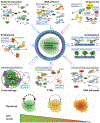Stress granule and P-body clearance: Seeking coherence in acts of disappearance
- PMID: 38278052
- PMCID: PMC10939798
- DOI: 10.1016/j.semcdb.2024.01.002
Stress granule and P-body clearance: Seeking coherence in acts of disappearance
Abstract
Stress granules and P-bodies are conserved cytoplasmic biomolecular condensates whose assembly and composition are well documented, but whose clearance mechanisms remain controversial or poorly described. Such understanding could provide new insight into how cells regulate biomolecular condensate formation and function, and identify therapeutic strategies in disease states where aberrant persistence of stress granules in particular is implicated. Here, I review and compare the contributions of chaperones, the cytoskeleton, post-translational modifications, RNA helicases, granulophagy and the proteasome to stress granule and P-body clearance. Additionally, I highlight the potentially vital role of RNA regulation, cellular energy, and changes in the interaction networks of stress granules and P-bodies as means of eliciting clearance. Finally, I discuss evidence for interplay of distinct clearance mechanisms, suggest future experimental directions, and suggest a simple working model of stress granule clearance.
Keywords: Chaperones; Cytoskeleton; G3BP; Granulophagy; MRNA; MRNA decay; P-bodies; Phosphorylation; Proteasome; RNA helicases; RNA modification; Stress Granules; Translation; Ubiquitination; VCP.
Copyright © 2024 Elsevier Ltd. All rights reserved.
Conflict of interest statement
Declaration of Competing Interest I declare that I have no competing interests with regards to publication of the review “Stress granule and P-body clearance: seeking coherence in acts of disappearance”.
Figures

Similar articles
-
Deciphering the RNA Landscape of RNA Granules.Biochemistry. 2025 Aug 5;64(15):3156-3164. doi: 10.1021/acs.biochem.5c00265. Epub 2025 Jul 22. Biochemistry. 2025. PMID: 40696710 Review.
-
Polysome collapse and RNA condensation fluidize the cytoplasm.Mol Cell. 2024 Jul 25;84(14):2698-2716.e9. doi: 10.1016/j.molcel.2024.06.024. Mol Cell. 2024. PMID: 39059370 Free PMC article.
-
Measures implemented in the school setting to contain the COVID-19 pandemic.Cochrane Database Syst Rev. 2022 Jan 17;1(1):CD015029. doi: 10.1002/14651858.CD015029. Cochrane Database Syst Rev. 2022. Update in: Cochrane Database Syst Rev. 2024 May 2;5:CD015029. doi: 10.1002/14651858.CD015029.pub2. PMID: 35037252 Free PMC article. Updated.
-
The proteome and transcriptome of stress granules and P bodies during human T lymphocyte activation.Cell Rep. 2023 Mar 28;42(3):112211. doi: 10.1016/j.celrep.2023.112211. Epub 2023 Mar 7. Cell Rep. 2023. PMID: 36884350
-
Stress granule clearance mediated by V-ATPase-interacting protein NCOA7 mitigates ovarian aging.Nat Aging. 2025 Aug;5(8):1548-1567. doi: 10.1038/s43587-025-00927-w. Epub 2025 Jul 31. Nat Aging. 2025. PMID: 40745099 Free PMC article.
Cited by
-
PLAA/UFD-3 regulates P-bodies through its intrinsic disordered domain.Proc Natl Acad Sci U S A. 2025 Jul;122(26):e2427250122. doi: 10.1073/pnas.2427250122. Epub 2025 Jun 25. Proc Natl Acad Sci U S A. 2025. PMID: 40560612
-
Quitting Your Day Job in Response to Stress: Cell Survival and Cell Death Require Secondary Cytoplasmic Roles of Cyclin C and Med13.Cells. 2025 Apr 25;14(9):636. doi: 10.3390/cells14090636. Cells. 2025. PMID: 40358161 Free PMC article. Review.
-
Cytoplasmic mRNA decay and quality control machineries in eukaryotes.Nat Rev Genet. 2025 Jul;26(7):463-478. doi: 10.1038/s41576-024-00810-1. Epub 2025 Jan 27. Nat Rev Genet. 2025. PMID: 39870755 Review.
-
Assembly and disassembly of stress granules in kidney diseases.iScience. 2025 May 24;28(6):112578. doi: 10.1016/j.isci.2025.112578. eCollection 2025 Jun 20. iScience. 2025. PMID: 40546967 Free PMC article. Review.
-
Regulation of physiological and pathological condensates by molecular chaperones.FEBS J. 2025 Jul;292(13):3271-3297. doi: 10.1111/febs.17390. Epub 2025 Jan 5. FEBS J. 2025. PMID: 39756021 Free PMC article. Review.
References
-
- Hirose T, Ninomiya K, Nakagawa S & Yamazaki T A guide to membraneless organelles and their various roles in gene regulation. Nature Reviews Molecular Cell Biology 2022 24:4 24, 288–304 (2022). - PubMed
Publication types
MeSH terms
Substances
Grants and funding
LinkOut - more resources
Full Text Sources
Miscellaneous

